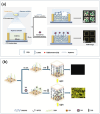Recent Progress in Biosensors for Depression Monitoring-Advancing Personalized Treatment
- PMID: 39329797
- PMCID: PMC11430531
- DOI: 10.3390/bios14090422
Recent Progress in Biosensors for Depression Monitoring-Advancing Personalized Treatment
Abstract
Depression is currently a major contributor to unnatural deaths and the healthcare burden globally, and a patient's battle with depression is often a long one. Because the causes, symptoms, and effects of medications are complex and highly individualized, early identification and personalized treatment of depression are key to improving treatment outcomes. The development of wearable electronics, machine learning, and other technologies in recent years has provided more possibilities for the realization of this goal. Conducting regular monitoring through biosensing technology allows for a more comprehensive and objective analysis than previous self-evaluations. This includes identifying depressive episodes, distinguishing somatization symptoms, analyzing etiology, and evaluating the effectiveness of treatment programs. This review summarizes recent research on biosensing technologies for depression. Special attention is given to technologies that can be portable or wearable, with the potential to enable patient use outside of the hospital, for long periods.
Keywords: biosensors; depression; personalized treatment.
Conflict of interest statement
The authors declare no conflicts of interest.
Figures















Similar articles
-
Recent Progress in Wearable Biosensors: From Healthcare Monitoring to Sports Analytics.Biosensors (Basel). 2020 Dec 15;10(12):205. doi: 10.3390/bios10120205. Biosensors (Basel). 2020. PMID: 33333888 Free PMC article. Review.
-
Frontiers of Wearable Biosensors for Human Health Monitoring.Biosensors (Basel). 2023 Oct 31;13(11):964. doi: 10.3390/bios13110964. Biosensors (Basel). 2023. PMID: 37998139 Free PMC article.
-
Skin-Interfaced Wearable Sweat Sensors for Precision Medicine.Chem Rev. 2023 Apr 26;123(8):5049-5138. doi: 10.1021/acs.chemrev.2c00823. Epub 2023 Mar 27. Chem Rev. 2023. PMID: 36971504 Free PMC article. Review.
-
The Emergence of AI-Based Wearable Sensors for Digital Health Technology: A Review.Sensors (Basel). 2023 Nov 29;23(23):9498. doi: 10.3390/s23239498. Sensors (Basel). 2023. PMID: 38067871 Free PMC article. Review.
-
From population-based to personalized laboratory medicine: continuous monitoring of individual laboratory data with wearable biosensors.Crit Rev Clin Lab Sci. 2025 May;62(3):198-227. doi: 10.1080/10408363.2025.2453152. Epub 2025 Feb 1. Crit Rev Clin Lab Sci. 2025. PMID: 39893518 Review.
Cited by
-
Integration of Multi-Modal Biosensing Approaches for Depression: Current Status, Challenges, and Future Perspectives.Sensors (Basel). 2025 Aug 7;25(15):4858. doi: 10.3390/s25154858. Sensors (Basel). 2025. PMID: 40808021 Free PMC article. Review.
References
-
- Bertolote J.M., Fleischmann A. A global perspective in the epidemiology of suicide. Suicidology. 2002;7:6–8. doi: 10.5617/suicidologi.2330. - DOI
Publication types
MeSH terms
Grants and funding
LinkOut - more resources
Full Text Sources
Medical

